If you are the outdoor type, camping is easily one of the best ways to spend your free time.
Personally, I love camping, and I’ve spent dozens of nights sleeping in the wilderness while surrounded by the sounds of creaking trees and croaking frogs.
While friends and significant others can make great companions for camping trips, there may be no better sidekick for your next outdoor adventure than a courageous and cuddly canine.
Most dogs love getting the chance to rough it for a few days in the wilderness. It gives them the opportunity to chase squirrels, sample a number of strange odors, and zoom around to their heart’s content.
But you can’t just grab your pup and hit the trail. You’ll need to prepare properly before going camping with your dog to ensure everyone has a good time.
Among other things, this means examining your tent and making sure that it’ll work well for you and your pooch. Or, if you’re starting from scratch and don’t have a tent already, you’ll want to be sure you pick one that will suit you both.
We’ll try to help you do this below, as we discuss the things you want to look for in a dog-friendly tent.
We’ll also recommend a few of the best options on the market and share a few important tips to help ensure your dog enjoys the trip and doesn’t suffer injuries or illnesses while you’re in the wilderness.
Quick Picks: Best Dog-Friendly Tents
See our top picks for best tents for camping with dogs below, or keep reading for full details!
| Preview | Product | Rating | Price | |
|---|---|---|---|---|

|
Coleman Evanston Screened Camping Tent, 6/8 Person Weatherproof Tent with Roomy Interior Includes... | 8,057 Reviews | $108.85 | Buy on Amazon |

|
Wenzel Klondike 8 Person Water Resistant Tent with Convertible Screen Room for Family Camping | 3,646 Reviews | $179.95 | Buy on Amazon |

|
Coleman Elite WeatherMaster Camping Tent with LED Lights and Screened Porch, Weatherproof 6-Person... | 1,155 Reviews | $310.89 | Buy on Amazon |

|
Mountainsmith Morrison 2 Person 3 Season Tent (Citron Green) | 737 Reviews | $103.15 | Buy on Amazon |

|
Coleman Steel Creek Fast Pitch Dome Tent with Screen Room, 6-Person , White, 10' x 9' | 2,038 Reviews |
$168.36 |
Buy on Amazon |
A Quick Note for Camping Newbies
Experienced campers can just skip this section, but outdoor novices will need to understand that there are two basic types of camping. You’ll need to figure out the type of experience you are looking for before you start packing and preparing.
Car Camping
Car camping is an easy form of camping that is great for families with young children and beginners (as well as those who want access to cold adult beverages during the trip, as you can bring a cooler).
It involves driving right up to the place you intend to pitch your tent, meaning that you won’t have to haul your gear deep into the woods on your back. You can car camp in relatively remote areas, but often car camping takes place at designated sites that are pretty easy to reach.

Potable water is often available at car camping sites, as are bathrooms, premade fire circles, designated tent pads, grills, and picnic tables. You’ll likely be camping alongside other people (and their dogs) too.
Because you won’t have to carry your gear on your back, you can bring anything you like while car camping. In this sense, car camping is often akin to staying in an outdoor hotel.
You can car camp with just about any dog. If your dog is happy hanging out with you during cookouts, she should enjoy car camping too.
Backpacking
Backpacking is considered the “real” camping in some circles. Instead of pitching a tent within sight of your car, you’ll park at a trailhead (typically a gravel parking lot near the start of the trail), slip on your pack and head off into the wilderness.
You’ll have to carry everything you’ll need, which means that you’ll enjoy fewer plush amenities during the trip.
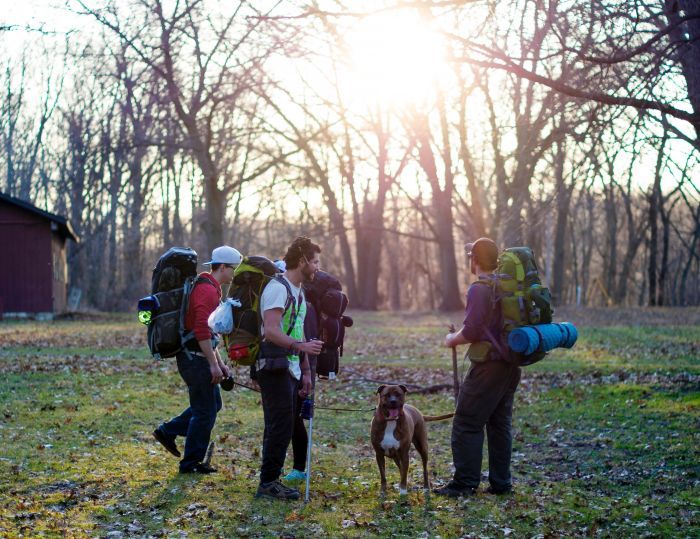
You’ll have to find and treat your own water, you’ll need to cook over a fire or camp stove, and you’ll be pooping in the woods. But, in exchange for enduring these indignities, you’ll be able to escape the real world and enjoy the Great Outdoors in a much more immersive manner.
Because you’ll have to carry your tent with you while backpacking, you’ll usually need to opt for a pretty small (and, more importantly, lightweight) tent model.
Cavernous 8-person tents will weigh too much for most backpackers, so you’ll generally be limited to 2-3 person models (it is possible to carry a heavy tent with you – I’ve done so once or twice – but it isn’t very fun). You’ll likely find that a 2-3 person tent will accommodate you, a human camping companion, and your dog, but things will be a bit tight.
Some dogs are more suitable for backpack camping trips than others. Some dog breeds are more capable of hiking long distances than others, and your dog will need to be healthy enough to walk several miles a day.
Small dogs may become exhausted trying to keep up with the group, and dogs who suffer from hip or joint problems may also struggle.
Just be sure to consider your dog’s health before heading out on a backpacking trip and consult your vet beforehand if you aren’t sure that she can handle the rigors of trail life for a few days.
What to Expect When You Go Camping with Your Dog
It’s important to understand what to expect when you go camping with your dog, even if you are a seasoned camper with dozens of dog-free trips under your belt.
All dogs and owners are individuals who’ll react differently to a trip through the wilderness, but the following generalities will usually apply.
Dogs Can Become Overwhelmed or Overstimulated by the Experience
Hanging out in the wilderness is a lot different than running around in the backyard, and the myriad sights, sounds, and smells confronting your dog can cause them to react in surprising ways.
Some dogs may become intimidated and stick close to your side, while others may become excited and dart off in an effort to explore this strange new world.

It can be hard to know which way your dog will react, so just be prepared for either possibility. Most dogs will calm down a bit as the trip progresses and start acting semi-normally again, but you’ll want to be extra alert to your dog’s needs until she does.
Minor Intestinal Disturbances Are Pretty Common
Your dog will spend a lot of time sniffing the ground, drinking from mud puddles, and tasting things she finds on the trail, which means she’ll likely ingest plenty of bacteria, protozoans, and other pathogens.
This can upset your dog’s stomach pretty significantly and cause her to spend more time pooping than normal.
Minor intestinal disturbances are rarely cause for concern, but if your dog suffers from unrelenting diarrhea that lasts more than 48 hours, you’ll want to cut your trip short and head to the vet (if you have cell service, you may be able to contact your vet by phone instead of heading home early).
You’ll want to do what you can to help limit the amount of grody stuff your dog eats and drinks.
Just keeping your dog on a leash or tether will help prevent her from licking carcasses or slurping up mouthfuls of mud, and if you give her water several times a day, you’ll help reduce the amount of dirty water she drinks.
If you are car camping at a plush campsite with bathrooms and running water, be sure to use tap water for filling your pet’s bowl.
Similarly, backpackers would be wise to treat their dog’s water in the same way they treat their own water (simply put, you’ll want to use purification tablets, filter the water, or boil it). Also consider nabbing a dog-friendly water bottle if you’d rather share water with Fido from one container!
Dogs Can Act in Unpredictable Ways Around Wildlife
You may be pretty familiar with the way your dog reacts to cats, dogs, and squirrels running around the neighborhood, but you can’t be sure how your pup will react the first time she sees an opossum, skunk, or bear.

Some dogs will turn tail and run, while others will react defensively. Some may even become outright aggressive.
Bears, coyotes, and other large animals can obviously injure your pet, but small critters can also represent a danger. Rodents can pass plague-carrying fleas to your pet, and small carnivores — such as raccoons and skunks — can carry rabies.
Accordingly, it is wise to keep your dog securely leashed or tethered while in the wilderness.
As training expert Kayla notes in her guide for choosing the best dog hiking harness – you really shouldn’t let your dog off-leash in the woods unless you’re willing to bet $100 that your pooch will come back when called. If you’re not confident with your dog’s recall, opt for a long line leash until you know for sure!
Ultimately, despite advice saying otherwise, we know most owners will probably want to let their dog off-leash at some points during camping. Just make sure you use discretion and that you’re smart about when and where you let your pooch go free.
Also, although encounters with snakes aren’t nearly as common as many people fear, go check out our article about snake bite in dogs before heading off into the wilderness.
Feeding Your Dog Will Be a Bit Different on the Trail
Dinnertime during a camping trip won’t unfold the same way it does at home, and you’ll have to make a few adjustments when giving your dog food and water on the trail.
For example, you’ll need to figure out what kind of food to bring.
You can bring canned or wet foods along, but this means you’ll have to haul the cans or containers for the duration of the trip. There’s also no way to store opened cans safely while camping, so you’ll need to feed the entire contents to your dog at one time.

Kibble can be packaged in bulk, but it can also take up quite a bit of space in your pack, especially if you need enough to keep a big dog fed during a long camping trip. On the other hand, kibble doesn’t have a lot of water in it which means it won’t spoil during your trip and that it is pretty light.
You can also use semi-moist foods when camping. I’ve usually preferred going this route (I’ve always used Purina Moist & Meaty Burger and Cheese Packets to keep dogs fed while camping), as semi-moist foods are usually conveniently packaged in single (or half-sized) servings, and they’re pretty lightweight too.
They also provide a bit more fat than kibble in most cases.
This additional fat content not only serves as an efficient way to carry more calories (fats contain more calories per unit of weight than proteins or carbs do), extra fat usually equals extra flavor, so it’s a nice “vacation food” for your dog.
Just be mindful that abrupt food changes can be hard on the stomachs of some dogs. My dogs have never had a problem switching foods during camping trips, but yours may.
It’s not a bad idea to try out the food you intend to use a few weeks before you leave so you can determine whether or not your dog will digest the new food well.
And don’t forget that you’ll also have to bring along a dish to feed your pup from. I’ve just used a canine-friendly frisbee in the past, as it doubles as both a toy and feeding dish, but you may want to use a collapsible feeding dish instead.
Your Dog May Experience Sleep Disturbances
All of the activity surrounding your camping adventure may cause your dog’s sleeping habits to change in a number of ways.
Some dogs may end up taking longer mid-day naps than usual to recover from all of the exercise they’re getting. Others may have trouble sleeping soundly, due to all of the excitement and unusual stimuli.

This is rarely cause for concern. There’s nothing wrong with your dog catching some extra Zs when she needs them, and dogs who fall behind on their sleep during a trip will usually just make up for lost time once you head home (mine have always slept the entire ride back to civilization).
But, you’ll want to do everything you can to make sure that your dog feels comfortable so she’ll have the best chance of sleeping somewhat normally.
For example, if your dog normally sleeps with you in your bed, you’ll probably want to let her snuggle up next to you at night.
On the other hand, if your dog normally sleeps in her own bed or inside a kennel, you’ll want to consider bringing these items along (check out our articles about portable camping dog beds and soft-sided canine crates to see some great options for your next trip).
Things to Look for in a Dog-Friendly Tent
To the best of our knowledge, there aren’t any full-size tents on the market designed specifically with dogs in mind (there are small “pup tents” available, but we’ll talk about these later).
If you know of one that is, please share it with us! We’d love to include it in future article updates.
As it stands, you’ll have to look for regular tents that happen to have dog-friendly features. Some of the most important include:
Rugged Materials Are a Must
Your dog’s claws can quickly tear through the sides and floor of flimsy tents, so be sure that you stick to models made from thick fabrics. This won’t completely eliminate the possibility of rips or tears, but it will make them much less likely.
Thick and durable fabrics are more common in the large, family-style tents typically used for car camping than they are in the ultralight tents designed for backpackers for whom every ounce counts.
Just be sure to avoid bargain-priced tents of either variety, as they’re rarely made from durable materials.

It’s also a good idea to trim your dog’s nails before the trip. I actually like to use a dog nail grinder instead of clippers, as this allows you to create smoother, rounded tips on your dog’s nails (plus, some dogs seem to find the nail-grinding process pretty relaxing and spa-like).
Vestibules Are Helpful
Vestibules (auxiliary rooms that are attached to tents – they’re often screened) are very helpful for managing your dog during the trip.
As long as the weather is nice, you can let your dog sleep in the vestibule if the tent’s main compartment is relatively small. A vestibule also makes a great place for your pup to snooze after swimming, as it’ll keep her from getting your sleeping bag wet.
You can also sequester her inside the compartment while you’re cooking or doing other things that require your full attention. This will help keep her safe and out of your way.
Because she’ll still be able to see you (and smell what you’re cooking), she’ll likely remain calmer than if you sealed her up inside the tent, which could make her feel isolated.
Opt for a Slightly Larger Size than You Normally Would
While a vestibule can help provide some additional space for your pooch, it’s usually still a good idea to pick a slightly larger tent than you normally would. Even if you plan on letting your pup sleep in the screened extension, poor weather may require you to let your pooch sleep inside.
So, if you would normally consider a 2-3 person tent the ideal size for you, you may want to instead look for a 3-4 person model.
This is obviously easier for car campers than it is backpackers, but the benefits this extra space provides will usually offset the increased weight you’ll need to carry.
Twin-Door Models Offer Extra Convenience
Getting into and out of a tent can be a bit of an ordeal – especially if you are using a small tent designed for backpacking. You’ll often have to climb over your companion (whether canine or human), and it can also be tricky to move gear in and out of the tent if someone is already inside.
A two-door tent solves a lot of these problems. Instead of having to roll over your partner, you can just exit the tent via your own door. And this will provide similar benefits from a dog-management point of view.
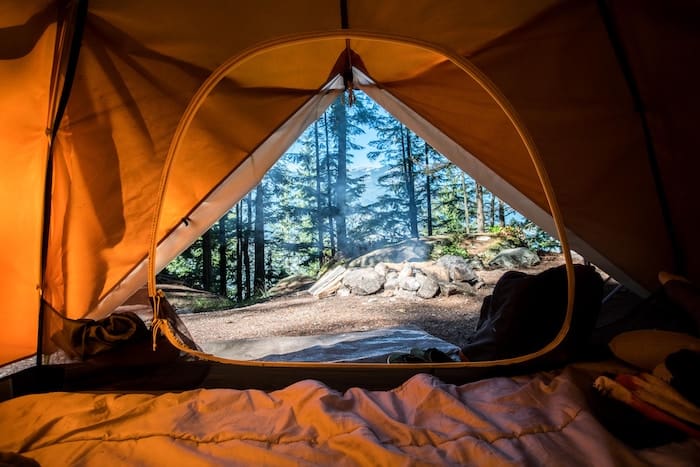
Five Best Dog-Friendly Tents
The following five tents are the best choices available for those who want to take their dog camping.
We’ve focused on car camping models, as that’s likely the type of camping most of our readers will enjoy, but we’ve also included a backpacking model which is light enough to haul into the wilderness.
Just be sure that you select a tent that suits your camping style and the climate you’ll face while enjoying the great outdoors!
1. Coleman Evanston Screened Tent
About: The Coleman Evanston Screened Tent is an affordable yet high-quality tent. It is primarily designed for car-camping families, but backpackers willing to carry a heavier pack than normal may find it useful too.
It consists of a main compartment and an attached, screened vestibule.
- Made in the USA or Imported premium polyester taffeta 75D material
- Weatherproof: Welded corners and inverted seams keep water from getting in; Included rainfly offers...
- Roomy interior: 10 x 9 feet with 5 feet 11 inch center height; Fits 2 queen-size air beds
- Conventional Pitch: Sets up in 15 minutes
Features: The Coleman Evanston Screened Tent is made from 75D polyester taffeta, which means that while it’s probably not rugged enough for hiking the Appalachian Trail with your pet, it’ll stand up to weekend camping trips.
Like some other Coleman tents, the Evanston Screened Tent features the manufacturer’s patented WeatherTec technology, which includes welded floor boundaries and inverted seams to help prevent leaks and keep you dry. It is also an easy tent to pitch, and the manufacturer claims most people can do so in 15 minutes.
This single-door tent features screened viewing windows that’ll help keep air moving through the tent, and the rainfly creates awnings over the windows so that you can keep them open when it rains.
It also comes with storage pockets and a convenient carrying bag.
Size: This is a 6-person tent. The main compartment measures 10’ x 9’ and the attached screened vestibule measures 10’ x 5’. It measures 5’ 8” tall in the center and weighs approximately 21 pounds.
PROS: Most customers who tried the Coleman Evanston Screened Tent were happy with the product. Many noted that it was easy to pitch and provided plenty of space to stretch out in the main compartment. Despite complaints about the screened porch (more on this below), the main compartment appears to be resistant to rain and moisture.
Of special note for K9ofMine readers, a few owners mentioned using it with their dogs, and one customer even shared a photo of (what appears to be) a full-grown Doberman snoozing comfortably inside.
CONS: While the majority of customers who tried the Coleman Evanston Screened Tent seemed to like their choice, there was one repeated complaint: The rainfly does not provide sufficient protection from the rain for the screened portion of the tent. This may be a big deal or only a minor problem, depending on how you plan to use the screened area.
2. Wenzel 8-Person Klondike Tent
About: The Wenzel 8-Person Klondike Tent is a big, spacious tent that is ideal for car campers who want plenty of room to stretch out. The main compartment is quite roomy (the manufacturer contends it provides sleeping space for 5 adults), and the screened portion is more of a proper room than a vestibule.
- Convertible screen room with inverted "T" style door and inside flap zippered windows
- Removable seam-sealed fly provides versatility
- Mesh roof vents, 2 zippered side windows with inside flaps
- Shock corded fiberglass roof frame with steel uprights and corner elbows combined with pin & ring...
Features: This is a big tent made from durable materials to ensure it lasts for years.
Although many portions of the tent are screened (including the entire roof), the sides and floor are made from weather-resistant polyester with a polyurethane coating. All of the seams are lap-felled and double-stitched, and the zippers are treated with water-repelling chemicals to help keep you dry.
It also features double-staked power corners which provide stability in windy weather.
The internal wall separating the main compartment from the screened area can be zipped up completely. It comes with two hanging storage compartments and a duffel-style carrying bag. It is also backed by a 10-year warranty against defects.
Size: This is an 8-person tent. The main compartment measures approximately 11’ x 9’, while the screened compartment measures approximately 6’ x 7’ (the tent’s odd shape makes exact measurements difficult to provide). The tent is 6.5 feet tall in the center of the main compartment, and the entire tent weighs approximately 25 pounds.
PROS: The Wenzel 8-Person Klondike Tent received pretty positive reviews from most owners. Many praised the amount of space provided and the tent’s design, which helped make it easier to keep the interior neat and organized. Several also mentioned that it was relatively easy to pitch.
CONS: Most complaints about the Wenzel 8-Person Klondike Tent were minor. A few owners noted that the tent became quite hot in the summer, and several experienced problems getting the side walls completely smooth (they tended to bunch and wrinkle).
3. Coleman Elite WeatherMaster 6 Screened Tent
About: The Coleman Elite WeatherMaster 6 Screened Tent is a well-made and spacious tent that comes with a few nifty features that may help you enjoy your next outing.
Burly backpackers may consider hauling this tent on the trail, but it is probably best-suited for car campers who want to spend their outdoor time in relative luxury.
- 6-person camping tent with built-in illumination for family or group trips
- LED system offers three brightness settings for overhead interior light
- Attached 9 x 6 ft. screen room offers bug-free area for relaxation
- Spacious interior has room for 2 queen airbeds
Features: The Coleman Elite WeatherMaster 6 – like many other Coleman tents – is made from 75D polyester taffeta, which provides a good combination of weight and durability for weekend campers. The tent features a two-room design – the main interior compartment and an attached screened compartment.
This is a single-door tent, so you can’t enter or exit via the screened compartment. The seams are all weather-protected, and the zippers all feature protective flaps to keep water out.
The floor features a welding-inspired design, which alleviates the need for stitching and therefore helps keep the interior dry.
But here’s the really neat thing about this tent: It features a built-in LED light system. This means you’ll be able to see easily in the tent at night (or during rainy weather) without having to hang a lantern inside. The lighting system can be adjusted to provide three different levels of illumination.
Note that Coleman produces another, similar tent, called the Coleman Weathermaster 6-Person Tent. Although we believe the Elite Weathermaster is the better option and comes with more features, the “regular” Weathermaster has many more customer reviews. This may appeal to some buyers – just give each model a look.
Size: This is a 6-person tent. The entire tent measures 17’ x 9’ and the highest point is 6’ 4” above the ground. The screened portion of the tent measures 9’ x 6’ (included within the total tent size), while the main compartment is large enough to accommodate two queen-sized airbeds. This tent weighs 16.25 pounds.
PROS: Most owners seemed to like the Coleman Elite Weathermaster 6. It was praised for being spacious, weather-resistant, and easy to assemble. Lots of buyers liked the included illumination system and the electric cord port, which allows you to thread an extension cable through the side of the tent.
Also, a few owners shared photos of their happy pup (including an adult golden retriever), resting comfortably inside the tent.
CONS: There weren’t a ton of complaints about the Coleman WeatherMaster 6, and most of the problems mentioned were pretty minor. A few people complained about leaking windows, and a few were disappointed with the way the lighting system burned through batteries. A few also mentioned malfunctioning switches for the lighting system.
4. Mountainsmith Morrison 2-Person 3-Season Tent
About: Unlike many of the other tents we recommend which are too large and heavy for most backpackers, the Mountainsmith Morrison 2-Person 3-Season Tent is perfect for campers who plan on hiking into the wilderness.
It doesn’t provide the same amount of space as the other larger tents do, so you’ll have to snuggle up with your pet and conserve space while sleeping.
- Two door / Two vestibule layout
- Two person layout
- Three season, free standing tent
- Tent fly ventilation windows
Features: Because the Mountainsmith Morrison Tent has been designed with portability in mind, it doesn’t include a lot of the bells and whistles that car-camping tents do. It doesn’t come with lighting systems, nor does it feature multiple rooms. It is a basic compartment that gives you a place to sleep and store your gear.
However, it does have a few very helpful design features. For example, this tent comes equipped with two doors, which means that you and your pooch can exit and enter from either side.
Additionally, the tent’s rainfly is designed in a manner that provides two vestibules – one near each door. This will give your dog a small space to sleep or hang out.
Additionally, the Mountainsmith Morrison Tent features “bathtub floor construction,” meaning the bottom material extends up the sides of the walls a few inches. This significantly improves its ability to keep you and your belongings dry, and it also helps protect the walls from your dog’s claws a little bit.
This tent comes with a rainfly that provides ventilation windows and a water-resistant stuff sack that keeps everything dry while you’re on the trail.
Size: This is a 2-person tent that measures 56” x 92”. It is 43 inches high at the center, and each vestibule provides 7 square feet of space. This tent weighs only 4 pounds and 11 ounces.
PROS: The Mountainsmith Morrison received overwhelmingly positive reviews. Many praised the tent’s double-door design and durability, and several noted that it was easy to pitch. Numerous owners reported using the tent during the summer and winter with equal ease, and the poles, seams, and pole sleeves all appear well-made and durable.
Of all the tents we recommend here, the Mountainsmith Morrison is clearly the best option for backpackers.
CONS: Backpacking aficionados may quibble with a variety of things about this tent, but the biggest problem of note to most K9ofMine readers is clearly the lack of space provided by this tent. It does provide two individual vestibules, but they’re not very spacious. That said, there’s no real way around this issue: Backpacking tents have to be relatively small.
5. Coleman Steel Creek Fast-Pitch Dome Tent
About: The Coleman Steel Creek Fast-Pitch Dome Tent is designed for campers who want to spend their time enjoying nature rather than struggling to get their tent pitched.
This is another tent that is primarily designed for car campers, but some backpackers may find it light enough to carry.
- 6-person dome tent features a separate screen room for insect-less lounging and extra sleeping space
- Fast Pitch tent design sets up in about 7 minutes
- WeatherTec system and rainfly keep tent interior dry and comfortable
- Durable Polyguard fabric and strong frame designed to last season after season
Features: The Coleman Steel Creek Tent is surprisingly lightweight for its size and durability. It made from sturdy Polyguard fabric, which will help the tent stand up to years of use.
It features protected seams and zippers to help keep out the rain, and the floors use welded-inspired technology to ensure water doesn’t seep in around the bottom.
The feature most campers will appreciate most about the Coleman Steel Creek Tent is the fast-pitch design. It uses color-coded poles and easy-to-use pole hubs to make it easier to set up. According to the manufacturer, this system can reduce set-up time by 50%.
The Coleman Steel Creek Dome Tent also comes with reflective guylines (which is an important safety feature – you don’t want to trip over your guylines when you get up to pee in the middle of the night) and an expandable carrying case.
Size: This is a 6-person tent. The main compartment measures 10’ x 9’, and the screened room measures approximately 10’ x 5’. It is 5’ 8” tall in the center, and it weighs approximately 19 pounds.
PROS: Most customers seemed pretty happy with the Coleman Steel Creek tent. The fast-pitch design was widely praised, as was the tent’s waterproofing and construction. Several people who purchased this tent specifically noted that it provided great value, as it performed nearly as well as high-end tents, while still being very affordable.
CONS: There weren’t many problems reported by those who tried the Coleman Steel Creek Dome Tent. A few people complained that the screened compartment wasn’t very waterproof, and a few mentioned that it was heavier than they’d have liked, but this shouldn’t be a big problem for car campers.
An Alternative Approach For Camping With Canines
You don’t necessarily have to sleep alongside your dog when you go camping. In fact, you can provide your pup with her very own sleeping quarters.
About: The Lumsing Pet Tent is a pet-sized tent that comes with many of the design features that human-sized tents provide. In fact, not only would it be good for use on the trail, but it would give your dog a shady place to chill at the beach or dog park too.
No products found.
This may not be a valid approach for all dogs (my pooch would be quite offended if I didn’t let her sleep inside my tent), but many customers reported that their dog loved this tent. Some owners noted that their dog used the tent to escape from mosquitos and other biting bugs.
The Lumsing Pet Tent is relatively roomy and measures 45” x 32” x 27” high — roughly the same size as a large crate.
This means it should work for most large dogs, although gigantic mastiffs and Great Danes probably won’t fit inside. One owner who tried the tent mentioned that it was large enough for her German shepherd to rest comfortably inside.
The manufacturer describes the tent as waterproof, but while a few owners reported that it kept their pet dry during light rain, the tent may not work terribly well in true downpours.
It comes with fiberglass poles and windows with roll-up rain flaps which should keep the tent pretty stable and provide plenty of ventilation.
The tent comes with a carrying case and is very light (it weighs less than 2 pounds), so you may even be willing to bring it along on backpacking trips. It doesn’t come with guylines, so you will need to put something heavy in it if the winds start blowing.
PROS: A lot of dogs really seem to enjoy a tent of their own, and it’s large enough to fit most dogs comfortable. Plus, it’s fairly light, so shouldn’t be a huge pack burden. It’s also multi-use – a tent like this is a great shade shelter for hot days outdoors.
CONS: Some owners reported that this pet tent is fine for light rain, but doesn’t do well for really soggy downpours. The lack of guylines means you might need to weight down the tent if the wind picks up a lot.

Canine Camping Gear: Things You Need to Bring When Camping with Your Dog
In addition to the collapsible food dishes we mentioned earlier, there are a few other things you’ll want to consider bringing when you go camping with your dog.
Some of the most notable items you may want to consider include:
GPS Collar
One of the most important things to do when camping with your dog is to ensure that you don’t become separated from your pooch.
It may not be hard to find a dog wandering around the neighborhood, but tracking down your pup in a thousand-acre wilderness area will likely prove impossible.
Unless, that is, you fit her with a GPS collar. A GPS collar will allow you to track down your dog with the help of global positioning satellites. Different models work in different ways and exhibit varying ranges and features; some work with your cell phone, while others will work with an included hand-held receiver.
We’ve reviewed these collars before, so check out our full guide to dog GPS tracking collars to get the full low down!
Canine Backpack / Saddlebag
Although they don’t provide a ton of value for car campers, canine backpacks (aka saddle bags) are a great tool for backpacking campers.
A canine saddle bag will allow your dog to carry her own food, water, and collapsible food dishes, so you don’t have to add these items to your own pack.
Just be careful not to weigh down your pup too much – you want her to still feel nimble, and you don’t want to exhaust her. Most dogs healthy enough to go backpacking should be able to carry about 10% of their body weight, and some dogs may be able to comfortably carry 20% of their body weight or more.
Just be sure to watch your dog carefully while she’s carrying the pack, and don’t hesitate to remove weight if it appears to be giving her trouble.
There are a number of good canine saddle bags on the market, but the Outward Hound Daypak is a great choice that should work for most dogs.
It features multiple storage compartments, comfortable mesh webbing to allow her skin to breathe, and adjustable straps so you can achieve a good fit.
Canine Booties
Your dog’s paws may take a beating on the trail – particularly if you are hiking across rocky or sandy areas.
Her paws may also become chilly if you are camping in cold or rainy weather. A good pair of booties will help protect her paws and keep them warm too!

Booties will also help increase the visibility of your pet (four glowing booties prancing through the forest is a pretty cute thing to see), and it’ll help keep your tent cleaner if you take them off before letting her inside.
Check out our full review of dog booties to see a few of the best options available.
High-Visibility Harness
A harness is often a better option than a collar when you’re in the wilderness.
An outdoor-adventuring dog harness will not only give you better control over your dog if you encounter angry critters, but it’ll also allow you to help her negotiate obstacles like fallen logs and mud puddles.
When you pick out the harness, be sure to pick one that’s made from high-visibility materials and colors. This will not only make it easier for you to see your dog, it’ll help other campers see her more easily.
This will help avoid startling encounters as well as identify your dog as a pet, rather than a wild creature or feral dog.
Outerwear
A good coat or sweater should help keep your dog warm if you are camping during the late fall, winter, or early spring.

In fact, small and short-haired breeds may appreciate wearing a jacket during other portions of the year – it’s often a bit chilly at night and in the morning, even during summer trips.
It is also a good idea to bring a canine rain jacket for your pet so that she can continue to hike and explore if the weather sours.
Check out our reviews of cold-weather dog coats and canine rain jackets to browse some of the best options!
Don’t Forget Your Dog’s ID Tag
This should really go without saying, but make sure that your dog wears an easy-to-see ID tag when you go camping.
Even if she has a microchip implant and you fit her with a GPS collar, a dog ID tag is still important.
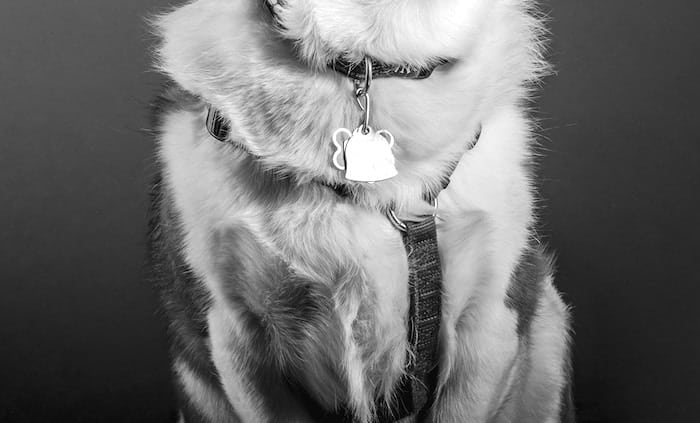
If other campers encounter your dog, they won’t be able to use the GPS collar or microchip to help reunite her with you (at least, not without the help of a vet or shelter to read the microchip).
But, if your dog is wearing an ID tag, they’ll be able to learn her name, see that she’s had her shots, and potentially contact you via the information provided.
Make Sure to Use a Preventative Flea and Tick Treatment
Bugs aren’t only a problem for people during camping trips – they’ll also make your dog miserable. And because you’ll be cohabitating with your dog in close-quarters, you are at risk from these types of bugs too.
Consequently, you’ll want to make sure that you apply a good preventative flea and tick treatment to your pet before the trip starts.
Note that mosquitoes are also a problem for dogs on the trail. These little pests aren’t only irritating for dogs, they can transmit heartworms too. Luckily, a few topical flea and tick treatments also provide protection from mosquito bites, such as K9 Advantix II.
Alternatively, if your typical flea and tick treatment doesn’t provide protection from mosquitos, you can use a DEET-free repellent (never use a mosquito spray containing DEET on your pet), such as Vet’s Best Mosquito Spray, which uses lemongrass and citronella to ward of blood-sucking bugs.
Camping may be fun, but it is even better when you bring your canine along on the adventure. Just be sure to prepare for the trip carefully and try to anticipate any needs your dog may have. Chances are, you and your pup will have a great time and look forward to the next chance you have to get out in the wilderness.
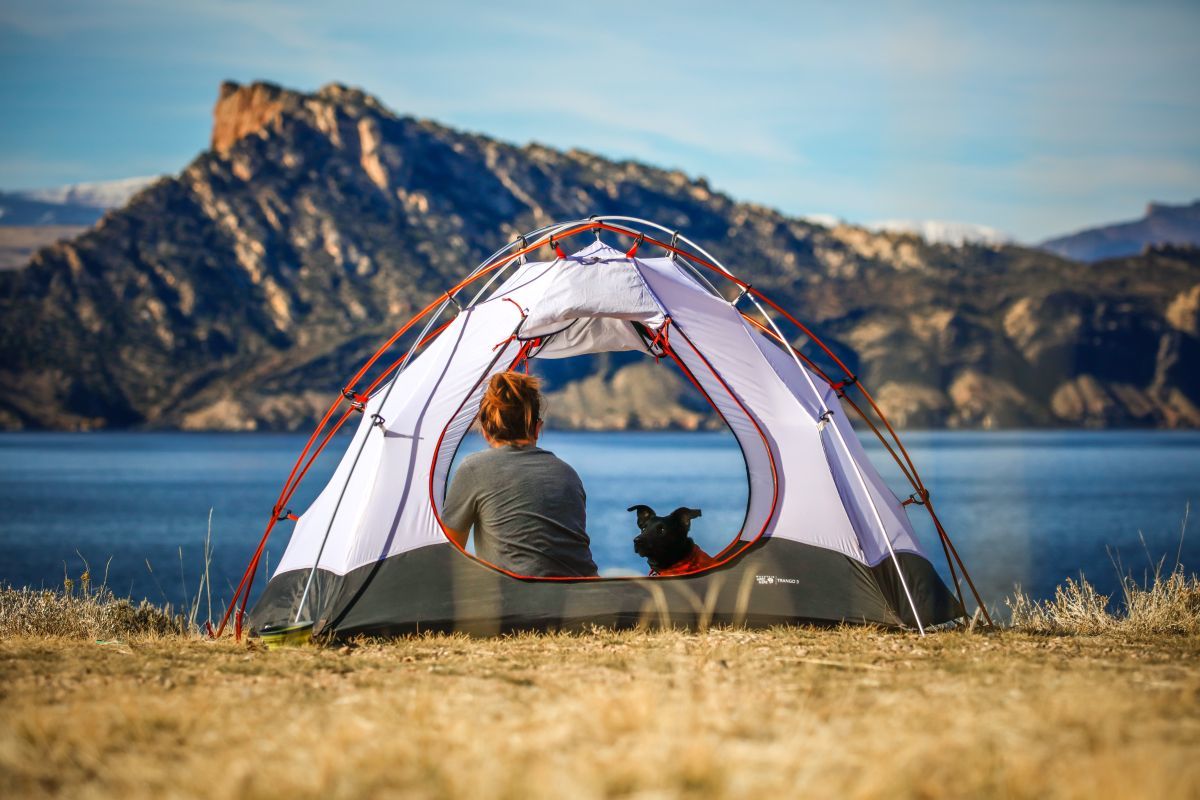




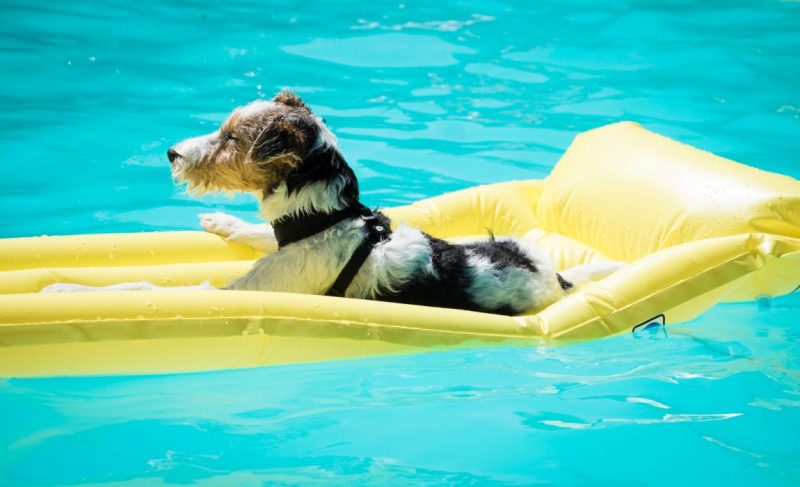
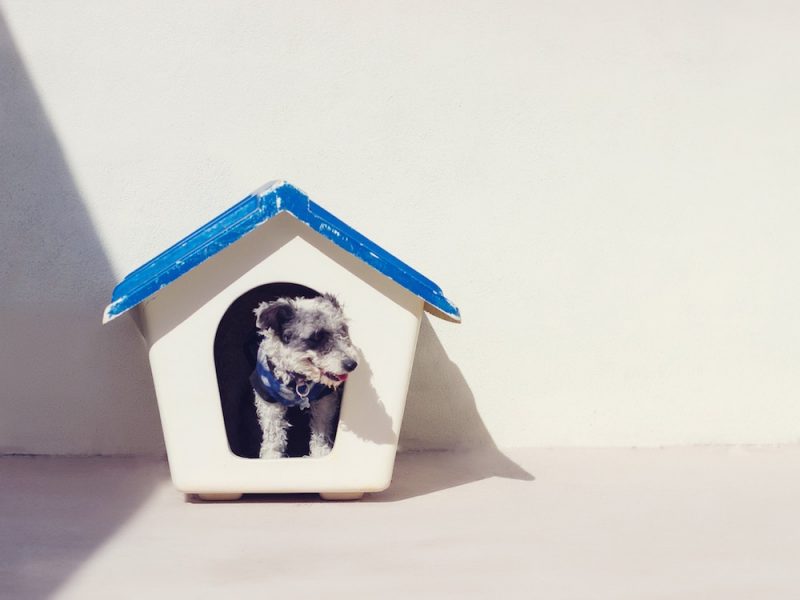

Leave a Comment